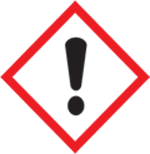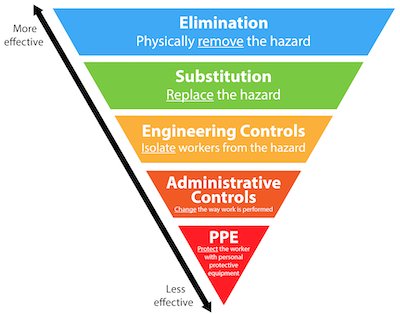Sodium Fluoride
This chemical standard operating procedure (SOP) and the associated Safety Data Sheet (SDS) are for our safety. Read and understand both documents. If this is a paper copy, check for updated versions on the IsoLab website.
Process
Sodium fluoride (NaF) is currently used as part of bacterial growth experiments and has been used historically for water fluorination.
Hazards - SDS


Toxic if swallowed. Causes skin irritation. Causes serious eye irritation.
Protection - SDS

Engineering Controls
Work with sodium fluoride in a fume hood. Ensure the fume hood has proper air flow by checking the flow rate on the control panel and / or using a smoke match or wipe to visualize flow.
PHS - Any of the fume hoods will provide you with protection, but since we use sodium fluoride in bacterial growth experiments, the cleanest hood is in 302C.
Administrative Controls
PHS - No specific administrative controls are required.
Personal Protective Equipment (PPE)
PHS - Wear a lab coat, nitrile gloves, and eye protection when working with sodium fluoride.
Handling - SDS
Keep container tightly closed when not in use. Keep away from water unless creating your bacterial media.
PHS - Decontamination - Make sure all NaF has been cleaned up and contained in appropriate containers before moving away from the fume hood. Ensure all utensils and trays have been wiped clean before removing them from the fume hood.
Storage - SDS
In general, sodium fluoride must be stored away from acids and water. Use MyChem, the UW EH&S chemical inventory database, to find exactly where in the lab suite this chemical is stored. Sodium fluoride is presently stored on shelf #1 on the south wall in 302B.
Spills - SDS
Apply calcium gluconate gel on skin exposure.
PHS - Exposure:
- Inhalation - Move to fresh air. For advice, call UW Employee Health Center (206.685.1026) or the Washington Poison Center (800.222.1222). For emergency help, call 911.
- Skin contact - Treat with calcium gluconate gel. Wash off with soap and plenty of water. For advice, call UW Employee Health Center (206.685.1026) or the Washington Poison Center (800.222.1222). For emergency help, call 911.
- Eye contact - Rinse thoroughly with plenty of water for at least 15 minutes. For advice, call UW Employee Health Center (206.685.1026) or the Washington Poison Center (800.222.1222). For emergency help, call 911.
If the spill is contained within the fume hood, close the sash and prepare yourself to clean it up. Don lab coat, nitrile gloves, and goggles. Avoid dust formation. Sweep and scoop trying to avoid using water. Place all debris into a plastic waste container.
If the spill is outside of the fume hood, avoid breathing dust. Don a respirator (303B west wall drawers), lab coat, nitrile gloves, and goggles. Avoid dust formation. Sweep and scoop trying to avoid using water. Place all debris into a plastic waste container.
If you need assistance or advice, use the IsoLab Emergency Contacts sheet.
Consult the EH&S Spill Poster and Exposure Poster
Waste - SDS
If you are cleaning up after a spill and have a bag of debris, ensure the bag is sealed and use multiple bags as needed. Complete an EH&S Hazardous Waste Label and adhere it to the bag. Here are instructions for how to label chemical waste containers. Labels are located in a drawer on the west wall of 303B near the door to the hallway.
Put all waste, solid or liquid, into a plastic container. Options for waste containers can be found under the west sink in 303B. Complete an EH&S Hazardous Waste Label and adhere it to the bottle. Here are instructions for how to label chemical waste containers. Labels are located in a drawer on the west wall of 303B near the door to the hallway.
Place the properly labeled container in one of the gray tubs near the hallway door of 303B. Segregate from other waste containers as appropriate.
Consult our generalized Chemical Waste Disposal SOP.

Training - PHS
Sodium fluoride is deemed a particularly hazardous substance - PHS by EH&S and you need approval before using it. Complete the list of requirements below before using this chemical.
Prerequisites
- You must have completed Managing Laboratory Chemicals in the last three years. Login to check.
- Read and understant the SDS for hydrofluoric acid.
- Read and understand the SDS for Sodium fluoride.
- Read, understand, and digitally sign this SOP.
- Contact your Principal Investigator (PI) AND the Chemical Hygiene Officer (CHO) indicating that you have completed all prerequisites and await approval.
